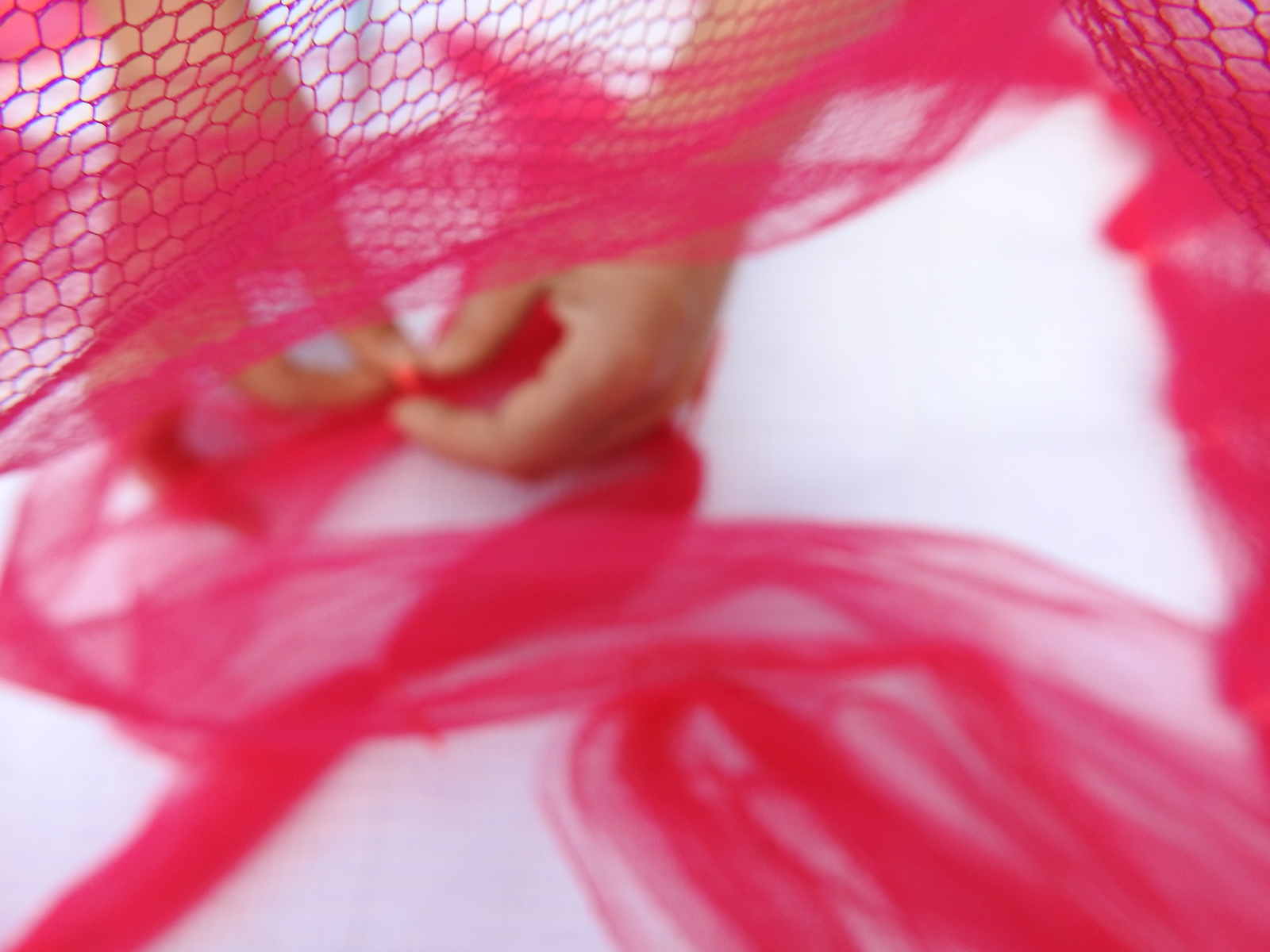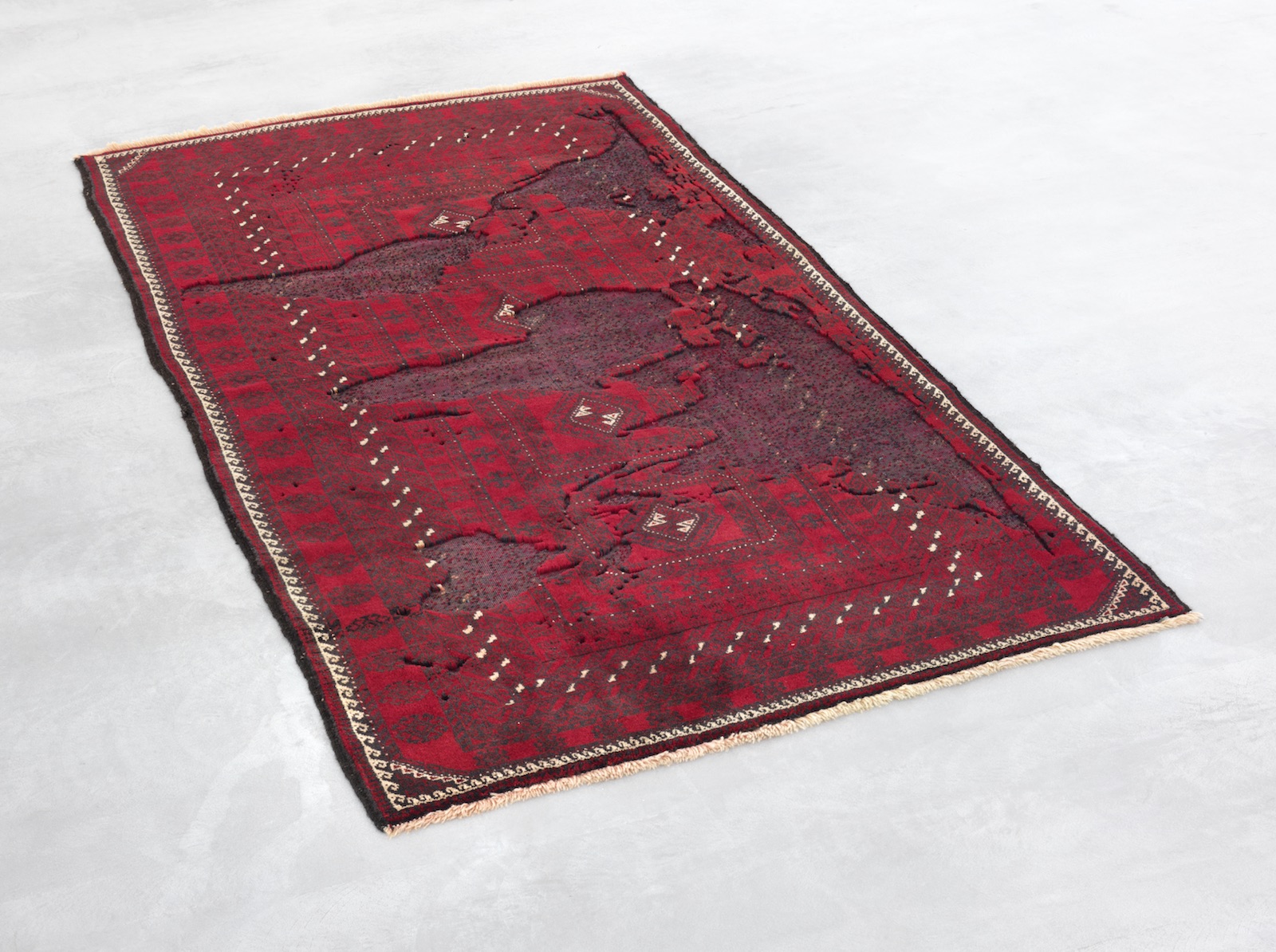
“Our debt is fundamentally towards women,” writes French-Algerian art historian and Rabat Biennale curator Abdelkader Damani, in his opening statement about the inaugural major art festival in Morocco’s capital city. The decision to focus primarily on contemporary women artists has yielded an impressive breadth of talent, spanning sixty-three artists and collectives and encompassing nearly thirty different nations and disciplines.
Highlights among these include the Palestinian multimedia visionary Mona Hatoum, Casablanca-born Deborah Benzaquen (whose neon-lit installation, Ou Sont Mes Reves? has a brilliantly trippy, clubby quality), the intricate and explicit embroideries of Egyptian New Yorker Ghada Amer, Zambian artist Milumbe Haimbe’s brilliantly subversive graphic novel frames, and Austrian artist/filmmaker Katharina Cibulka, who continues her Solange (As Long As) series in situ, with projected statements around the city (“As long as following our rules is more important than following our hearts, I will be a feminist”).

Damani is swift to allay suspicions that this might be a fleeting nod to gender equality; female and male artists are extensively featured together elsewhere in the biennale, including the Cartes Blanches segment based at Rabat’s Mohammed VI Museum (named for the country’s reigning king, and dedicated to modern and contemporary art), its film programme (which includes work by the award-winning director Tala Hadid—whose aunt, the legendary Iraqi architect Zaha Hadid, is also celebrated at Rabat), and its street art displays, headed up by US graffiti pioneer Futura.
“In my personal experience, Arab and African women of all nations and persuasions are palpably not silent or invisible”
“This will not be a biennale whose subject is women, any more than it will be an ode to an art construed as female, as minds accustomed to shortcuts may hastily and recklessly wish to see it, making women once again into an object of curiosity. Our ambition lies elsewhere,” insists Damani. He proposes that the biennale is a “forum for suggesting an alternative”: a kind of new world based on “the imaginations, the dreams and the demands of women”.

The biennale’s grand ambitions are delivered with serious intent, even if they do raise lingering questions. As the Moroccan art critic Syham Weigant notes (in her piece for the C& website)
: “By isolating a part of humanity, half of it, there is a risk of treating us as a minority and stigmatizing us even more… The title of the biennale, An Instant Before the World, may be seen as carrying a curtailed view of femininity, since it’s filtered through the prism of the male gaze.”
There is also the stickily persistent Western notion that while gender equality is a universal concern, having a prominent platform for female expressions is somehow at odds with Middle Eastern culture (this should be “cultures”, of course, but distinctly diverse Asian and African regions are still frequently addressed as homogenous masses). As a London-based woman of Iraqi descent, I’ve been aware of this premise for most of my life, and the longer it persists, the less sense it makes. I was raised in a culture of typically strong (and vocal) Arabic
As a London-based woman of Iraqi descent, I’ve been aware of this premise for most of my life, and the longer it persists, the less sense it makes. I was raised in a culture of typically strong (and vocal) Arabic women, and inspired by a wealth of female and male creative, scientific and sporting talents. I’m well aware of the discrepancies within Arabic cultures, and my teenage experience of living in the Gulf (specifically, Saudi Arabia’s Eastern province) was something of a baptism of fire, ablaze with racial and sexual inequalities and contradictions.

I’m also conscious of the everyday sexism that still prevails around my British home: the twenty-first-century fight to close the gender pay gap; the misogyny that lurks everywhere from the entertainment biz to the legal system. Ironically, even well-intended testimonies to global gender equality can end up strangely skewed; a few years ago, I wrote a BBC Culture feature documenting the long-standing tradition of powerful female singers across the Arabic music genre, which appeared under an odd headline (not my own): “The Arab women who refuse to be silent”. In my personal experience, Arab and African women of all nations and persuasions are palpably not silent or invisible; it’s peculiar to be continually informed that we are.
“I used to feel that Arab women were so strong-willed and had their own openness, even sexually”
The Middle East has historically encompassed hotbeds of art, and women artists in their midst. When I speak to the best-selling Lebanese novelist Hanan Al-Shaykh, she recalls growing up in the 1960s and seventies in Beirut (and moving to Cairo, aged eighteen, to begin her career as a journalist), and the international female artists that caught her attention at the time: the abstract works of Saudi-Kuwaiti painter Munira Al Kazi (in particular, her stark black depiction of “virginity”); the rich textures and hues of Lebanese painter and gallery founder Helen Khal (whose works were often likened to Rothko, and who also wrote the 1988 study The Woman Artist in Lebanon); the calligraphy-inspired designs of Princess Fahrelnissa Zeid (born in Istanbul, and later related to the Iraqi-Jordanian royal family); and the gloriously bold sculptures of Baghdad-born, Beirut-based Mouazzaz Rawda, who started studying art aged fifty.

Mona Hatoum, Baluchi, Red, 2007. Photo by Jens Ziehe, Berlin
“I loved how women artists thrived in the Arab world, and had their exhibitions in well-known galleries back then, and how they’re also now part of international collections including the Tate,” says Al-Shaykh. “When I was growing up, even in my neighbourhood in Beirut, I used to feel that Arab women were so strong-willed and had their own openness, even sexually; it always made sense to see that in visual art, too.”
“There is potential here for international connections within its theme of equality”
The first Rabat Biennale builds on a multi-stranded modern festival culture that has sparked, and occasionally struggled, in recent years—the well-regarded Marrakech Biennale had its 2018 edition cancelled after sponsors withdrew. There is potential here for international connections within its theme of equality, and even revelations within its more conventional elements; invariably, its homage to female creativity includes a dedication the legendary Egyptian singer Umm Kulthum, who performed a particularly celebrated concert in Rabat in 1968. This diva remains an extraordinary icon, somehow both traditional and visionary; her vocal prowess and onscreen roles (including that of a divorced single mother in the 1937 film Nashid Al Amal, aka The Chant of Hope). The biennale presents ample scope for nuance, at an apt point for a broader awakening.





